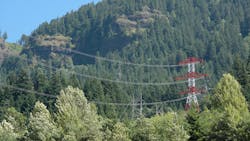Pacific Power Seeking Rate Increase to Support Wildfire Mitigation, Vegetation Management
PacifiCorp wants to raise electricity rates for Oregon customers by more than 12% in 2023 because of higher power costs, general inflationary pressure as well as increasing costs for wildfire planning and mitigation, according to proposals filed with state regulators.
The proposed hikes include a general rate increase to cover the costs of operating and maintaining the utility system as well as an annual power cost adjustment that covers the costs of electricity it buys on wholesale markets and the fossil fuels it purchases for its own generation plants.
It is the largest general rate increase the company has requested since 2010, and if approved, would be the first such increase since 2014. It will be subject to a 10-month regulatory review in which it is typically reduced, sometimes significantly.
Utility officials said that they are requesting an US$ 82.2 million increase in revenue. That’s 6.6% overall, but the impact differs by customer class. If approved as filed, it would represent a 9.1% increase for residential ratepayers, a 4.3% increase for general service commercial and industrial customers, and a 5.9% increase for large industrial customers.
The company concurrently filed for its annual power cost adjustment, proposing a 5.6% increase in rates. That increase also differs by customer class, and would amount to a 5.2% increase in rates for residential customers, 6.1% for general service commercial and industrial, and 7.7% for large industrial. Company officials, who will update the request in November, said that increase is being driven by inflation in wholesale electricity markets and natural gas commodity prices.
PacifiCorp supplies electricity to more than 600,000 Oregon customers under the name Pacific Power, making it the state’s second largest electric utility.
The company is facing a number of lawsuits stemming from the historic 2020 Labor Day fires that claim the company systematically underestimated fire risks in its service territory, underinvested in vegetation management and that its equipment was responsible for most of the destructive conflagrations that took place in 2020.
The company has accrued US$ 136 million in reserves to cover potential wildfire losses net of expected insurance recoveries. None of those costs are included in the proposal.
But a significant driver of the general rate increase request, accounting for about half of it, is future investments in wildfire planning and mitigation. That includes a big increase in tree trimming costs to keep limbs from contacting wires and potentially causing fires.
Aside from reviewing and authorizing rate increases, the Oregon Public Utility Commission also performs an annual audit of large utilities’ vegetation management programs. The commission has repeatedly concluded that PacifiCorp’s and Portland General Electric’s programs fall short of requirements. Its 2019 audit of PacifiCorp listed 27 pages of violations across the state. In 2020, there were 20 pages of violations listed.
Allen Berreth, vice president of transmission and distribution operations, said that the utility is moving from a four-year to a three-year trimming cycle along most of its transmission and distribution lines and will be inspecting its lines in high fire-risk areas annually and taking corrective actions. To manage the work, it is hiring more foresters and inspectors, and it is also seeing cost increases for the contract crews that do the trimming. To enhance its ability to monitor on-the-ground conditions, it also plans to expand the number of weather stations deployed across the state from 20 to 120 by the end of 2022.
Other factors driving the rate increase include cost recovery for the final phase a new Wyoming windfarm that became operational last year and general inflationary costs for labor, insurance and other items, company officials said. The company is also asking regulators to boost its profit margins, increasing its allowed return on equity from 9.5% to 9.8%, a request sure to be opposed by ratepayer advocates given the size of the general increases being sought.
“PacifiCorp always comes in wanting more money, more profits and less risk, so all of those elements are here,” said Bob Jenks, executive director of the Oregon Citizens’ Utility Board, a ratepayer advocacy group.
Matt McVee, PacifiCorp’s vice president of regulatory policy and operations, said that the utility has aggressively managed its costs, and will also be filing a proposal with regulators to offer discounted rates to low-income customers. In the meantime, he said that new factors, including extreme weather events and the general inflation impacting all households and businesses, are increasing utility costs, too.
“We do know it’s a big increase,” McVee said, adding that its last rate case ended with a rate decrease. If approved, he said, this would be the first general rate increase since 2014.
Commission staff will analyze the filings, and commissioners will take public feedback and input from various ratepayer groups over the next 10 months before issuing an order on the requests. New rates will be effective Jan. 1.
